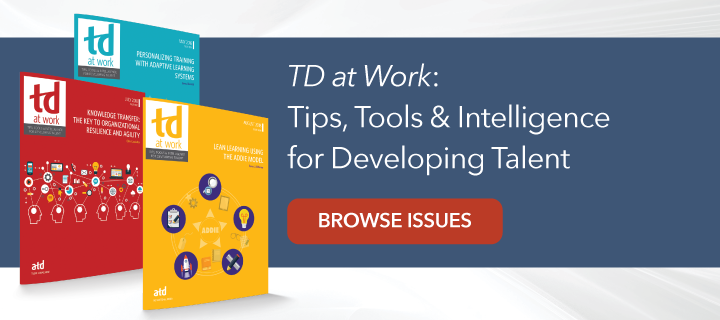Chris Cancialosi, the author of “Knowledge Transfer: The Key to Organization Resilience and Agility,” the July issue of TD at Work. He writes: “Knowledge doesn’t magically transfer from person to person. Developing an effective strategy for your organization requires first understanding how to transfer the knowledge.”
In a world of work where organizations are dealing with retiring Baby Boomers, employees who remain for a shorter time than historically has been the case, and even gig employees who work on a project and then move on to the next one, how do talent development professionals and leaders capture that knowledge and ensure that it is retained by the organization and transferred?
It requires both a strategy and the appropriate tools. Cancialosi suggests following steps outlined by Nick Bontis:
- Plan. Create a succession plan for each individual in your organization. If possible, you’ll want to implement a job shadowing program, whereby the inexperienced individual watches the tenured one and is provided useful feedback.
- Develop. While often not seen as a priority, it’s important to take the time to document every employee’s talent and expertise. When this information is in a searchable format, other employees know who to go to for answers.
- Communicate. One aspect of communication is interviewing all employees upon their transition. If it’s a case of an exit interview, you may want to use a third-part interviewer so the departing employee will feel free to be more honest and forthcoming. Further, “be sure to ask what the departing person knows that no one else in the company knows.”
- Create. If you’ve communicated correctly and employees have left on good terms, creating an alumni database that you can tap for intellectual capital down the road can be immensely beneficial.
- Enforce. Departing employees should understand fully that they are not able to take critical files with them when they leave the organization. Be sure that employees understand that this is a risk for the organization and there are legal implications.
In addition to a strategy for effective knowledge transfer, there are many tools talent development practitioners can use and encourage managers to use with their teams. A few of them are listed here.
- Simulations. While simulations may take creativity and a fair number of resources, they can provide a great return on investment. With today’s technology, simulations can allow employees to try out skills in a safe environment.
- Hackathons. Bringing together disparate talent, face-to-face, for a limited time can generate terrific ideas and learning in the moment among employees who normally would not share the information because of siloes or lack of proximity.
- Knowledge fairs. Typically, in-person events like knowledge fairs allow employees to showcase their knowledge and can improve engagement and organization morale.
- Storyboards. Think of the airline safety procedures brochures that demonstrate procedures in a visual manner. Storyboards can be especially useful for nonnative language speakers.
Additional tools and processes include job aids, job rotations, process documents, and mentoring programs, to name a few.
What is critical in terms of both processes and tools, though, is that an organizational culture exists that emphasizes the importance of using both to allow for knowledge generation, codification, and transfer.
To learn more, check out “Knowledge Transfer: The Key to Organization Resilience and Agility.”




